美国药典中的药品存储条件
- 格式:doc
- 大小:26.50 KB
- 文档页数:2
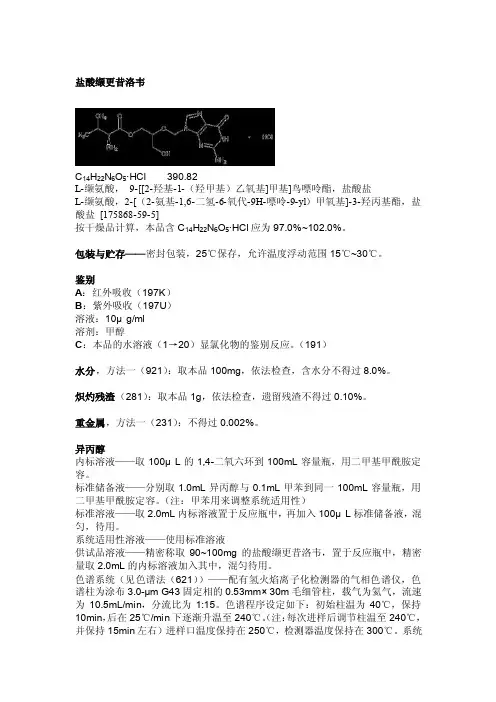
盐酸缬更昔洛韦C14H22N6O5·HCl 390.82L-缬氨酸,9-[[2-羟基-1-(羟甲基)乙氧基]甲基]鸟嘌呤酯,盐酸盐L-缬氨酸,2-[(2-氨基-1,6-二氢-6-氧代-9H-嘌呤-9-yl)甲氧基]-3-羟丙基酯,盐酸盐[175868-59-5]按干燥品计算,本品含C14H22N6O5·HCl应为97.0%~102.0%。
包装与贮存——密封包装,25℃保存,允许温度浮动范围15℃~30℃。
鉴别A:红外吸收(197K)B:紫外吸收(197U)溶液:10μg/ml溶剂:甲醇C:本品的水溶液(1→20)显氯化物的鉴别反应。
(191)水分,方法一(921):取本品100mg,依法检查,含水分不得过8.0%。
炽灼残渣(281):取本品1g,依法检查,遗留残渣不得过0.10%。
重金属,方法一(231):不得过0.002%。
异丙醇内标溶液——取100μL的1,4-二氧六环到100mL容量瓶,用二甲基甲酰胺定容。
标准储备液——分别取1.0mL异丙醇与0.1mL甲苯到同一100mL容量瓶,用二甲基甲酰胺定容。
(注:甲苯用来调整系统适用性)标准溶液——取2.0mL内标溶液置于反应瓶中,再加入100μL标准储备液,混匀,待用。
系统适用性溶液——使用标准溶液供试品溶液——精密称取90~100mg的盐酸缬更昔洛韦,置于反应瓶中,精密量取2.0mL的内标溶液加入其中,混匀待用。
色谱系统(见色谱法(621))——配有氢火焰离子化检测器的气相色谱仪,色谱柱为涂布3.0-µm G43固定相的0.53mm× 30m毛细管柱,载气为氦气,流速为10.5mL/min,分流比为1:15。
色谱程序设定如下:初始柱温为40℃,保持10min,后在25℃/min下逐渐升温至240℃。
(注:每次进样后调节柱温至240℃,并保持15min左右)进样口温度保持在250℃,检测器温度保持在300℃。
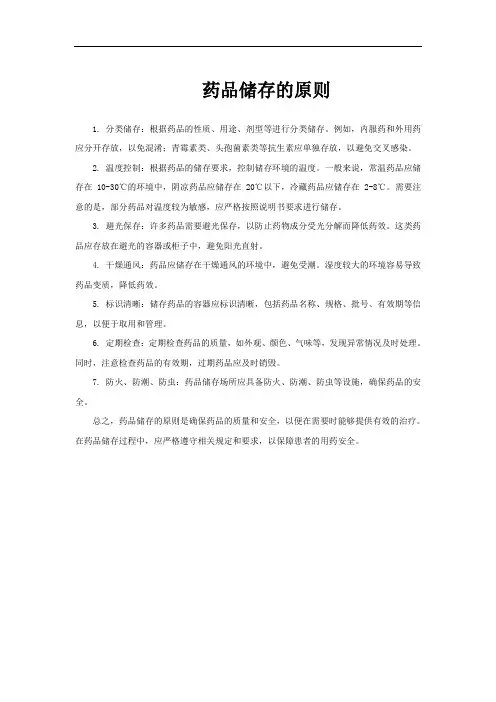
药品储存的原则
1. 分类储存:根据药品的性质、用途、剂型等进行分类储存。
例如,内服药和外用药应分开存放,以免混淆;青霉素类、头孢菌素类等抗生素应单独存放,以避免交叉感染。
2. 温度控制:根据药品的储存要求,控制储存环境的温度。
一般来说,常温药品应储存在 10-30℃的环境中,阴凉药品应储存在 20℃以下,冷藏药品应储存在 2-8℃。
需要注意的是,部分药品对温度较为敏感,应严格按照说明书要求进行储存。
3. 避光保存:许多药品需要避光保存,以防止药物成分受光分解而降低药效。
这类药品应存放在避光的容器或柜子中,避免阳光直射。
4. 干燥通风:药品应储存在干燥通风的环境中,避免受潮。
湿度较大的环境容易导致药品变质,降低药效。
5. 标识清晰:储存药品的容器应标识清晰,包括药品名称、规格、批号、有效期等信息,以便于取用和管理。
6. 定期检查:定期检查药品的质量,如外观、颜色、气味等,发现异常情况及时处理。
同时,注意检查药品的有效期,过期药品应及时销毁。
7. 防火、防潮、防虫:药品储存场所应具备防火、防潮、防虫等设施,确保药品的安全。
总之,药品储存的原则是确保药品的质量和安全,以便在需要时能够提供有效的治疗。
在药品储存过程中,应严格遵守相关规定和要求,以保障患者的用药安全。

各国药典储存条件汇总————————————————————————————————作者: ————————————————————————————————日期:药典储存条件的比较2012-11-27美国药典34 欧洲药典7.0 中国药典2010二部冷冻储存-25℃~-10℃深冷低于-15℃冷处不超过8℃冷处2℃~10℃控制的冷处2℃~8℃,允许在0℃~15℃之间冰箱中储存2℃~8℃阴凉储存8℃~15℃阴凉储存8℃~15℃阴凉处不超过20℃凉暗处避光并不超过20℃室温工作区的一般温度控制下的室温储存20℃~25℃,允许在15℃~30℃之间室温储存15℃~25℃常温10℃~30℃温暖30~40℃过热40℃以上干燥储存控制室温下湿度不超过40%见:药品GMP指南《质量控制实验室与物料系统》P387-388药典加速、长期试验条件的比较中国药典二部附录试验名称试验条件备注1 备注2加速试验(一般情况)温度40℃±2℃、相对湿度75%±5%所用设备应能控制温度±2℃,相对湿度±5%,并能对真实温度和湿度进行检测溶液剂、混悬剂、乳剂、注射液等含有水性介质的制剂可不要求相对湿度加速试验(中间条件) 温度30℃±2℃、相对湿度 65%±5%在温度40℃±2℃、相对湿度75%±5%加速6个月内不符合标准则采用该条件加速试验(温度敏感) 温度25℃±2℃、相对湿度60%±10%预计只能在冰箱中保存(4-8℃加速试验30℃±2℃、相对湿度 65%±5%乳剂、混悬剂、软膏剂、乳膏剂、糊剂、凝胶剂、眼膏剂、栓剂、气雾剂、泡腾剂及泡腾颗粒宜直接采用加速试验40℃±2℃、相对湿度25%±5%包装在半透明容器中药物制剂,例如低密度聚乙烯制备的输液袋、塑料安瓿、眼用制剂容器等长期试验(一般情况)温度在25℃±2℃、相对湿度 60%±10%或温度在30℃±2℃、相对湿度 65%±5%南方、北方气候差异长期试验(温度敏感)6℃±2℃长期试验温度在25℃±2℃、相对湿度 40%±5%或温度在30℃±2℃、相对湿度35%±5%包装在半透明容器中药物制剂选择由研究者决定药典加速、长期试验条件的比较ICH试验名称试验条件备注1 备注2 加速试验(一般情况) 温度40℃±2℃、相对湿度 75%±5%加速试验(中间条件) 温度30℃±2℃、相对湿度 60%±5%在温度40℃±2℃、相对湿度75%±5%加速6个月内不符合标准则采用该条件长期试验(一般情况) 温度在25℃±2℃、相对湿度 60%±5%美国药典USP35试验名称试验条件备注1备注2 加速试验温度40℃±2℃、相对湿度 75%±5%允许解释数据和信息的短期峰值在储存条件下除了受控室温允许的偏离长期试验温度在25℃±2℃、相对湿度60%±5%欧洲药品局试验名称试验条件备注1 备注2 影响因素试验温度:以10℃的增长量(10℃、2可评估药品在一定PH范围内的溶液或(原料药) 0℃、……50℃、60℃)高于加速试验相对湿度:≥75%混悬液对水解的敏感性光稳定性研究可作为影响因素试验的必要部分(条件按ICHQ1B)储存条件一般情况长期试验温度在25℃±2℃、相对湿度 60%±5%或温度30℃±2℃、相对湿度 65%±5%选择由研究者决定中间条件温度30℃±2℃、相对湿度65%±5% 若长期试验条件为温度30℃±2℃、相对湿度 65%±5%,则无中间条件若长期试验条件为温度25℃±2℃、相对湿度 60%±5%,且加速6个月内发生显著变化则应增加中间条件试验以评估显著变化的标准,最初申请应包括12个月的中间条件研究中至少6个月的数据加速试验温度40℃±2℃、相对湿度 75%±5% 储存条件在冰箱保存长期试验温度5℃±3℃加速试验温度在25℃±2℃、相对湿度 60%±5%储存条件冷藏长期试验温度-20℃±5℃加速试验在评估温度下进行,5℃±3℃或25℃±2℃储存条件低于-20℃根据个别方案而定制剂储存条件一般情况长期试验温度在25℃±2℃、相对湿度60%±选择由研究者决定5%或温度30℃±2℃、相对湿度65%±5%中间条件温度30℃±2℃、相对湿度65%±5% 若长期试验条件为温度30℃±2℃、相对湿度65%±5%,则无中间条件若长期试验条件为温度25℃±2℃、相对湿度60%±5%,且加速6个月内发生显著变化则应增加中间条件试验以评估显著变化的标准,最初申请应包括12个月的中间条件研究中至少6个月的数据加速试验温度40℃±2℃、相对湿度75%±5%储存条件不透水的容器可在任何可控的或环境湿度条件下进行储存条件半透水的容器长期试验温度在25℃±2℃、相对湿度 40%±5%选择由研究者决定或温度30℃±2℃、相对湿度 35%±5%中间条件温度30℃±2℃、相对湿度 35%±5% 若长期试验条件为温度30℃±2℃、相对湿度 35%±5%,则无中间条件若长期试验条件为温度25℃±2℃、相对湿度40%±5%,且加速6个月内发生除水分流失外的显著变化则应增加中间条件试验以评估30℃时温度的影响若加速试验中发生的显著变化只是水分流失,则不需要增加中间条件试验,但是应有数据证明在提供的有效期内在温度25℃±2℃、相对湿度40%±5%的条件下不会发生显著的水分流失加速试验温度40℃±2℃、相对湿度不大于25%储存条件冰箱长期试验温度5℃±3℃加速试验温度在25℃±2℃、相对湿度60%±5%储存条件冷藏长期试验-20℃±5℃无加速条件试验但规定在冷藏条件下储存的,应取一批在评估温度(5℃±3℃或25℃±2℃)下进行适当时间的试验,以说明短期内偏离标示储存条件的影响储存条件低于-20℃根据个别方案而定。
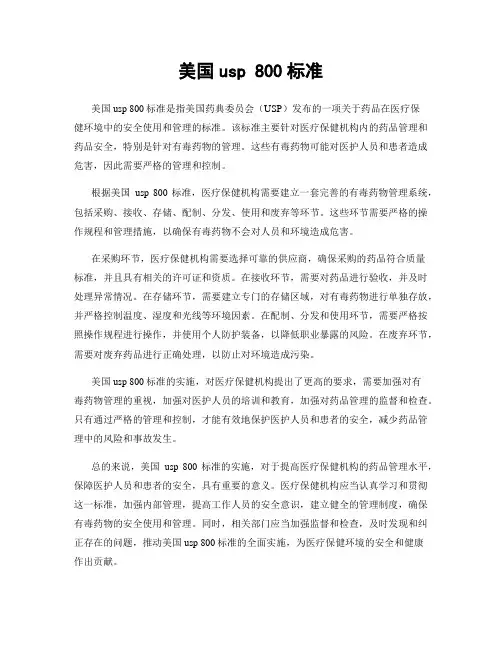
美国usp 800标准美国usp 800标准是指美国药典委员会(USP)发布的一项关于药品在医疗保健环境中的安全使用和管理的标准。
该标准主要针对医疗保健机构内的药品管理和药品安全,特别是针对有毒药物的管理。
这些有毒药物可能对医护人员和患者造成危害,因此需要严格的管理和控制。
根据美国usp 800标准,医疗保健机构需要建立一套完善的有毒药物管理系统,包括采购、接收、存储、配制、分发、使用和废弃等环节。
这些环节需要严格的操作规程和管理措施,以确保有毒药物不会对人员和环境造成危害。
在采购环节,医疗保健机构需要选择可靠的供应商,确保采购的药品符合质量标准,并且具有相关的许可证和资质。
在接收环节,需要对药品进行验收,并及时处理异常情况。
在存储环节,需要建立专门的存储区域,对有毒药物进行单独存放,并严格控制温度、湿度和光线等环境因素。
在配制、分发和使用环节,需要严格按照操作规程进行操作,并使用个人防护装备,以降低职业暴露的风险。
在废弃环节,需要对废弃药品进行正确处理,以防止对环境造成污染。
美国usp 800标准的实施,对医疗保健机构提出了更高的要求,需要加强对有毒药物管理的重视,加强对医护人员的培训和教育,加强对药品管理的监督和检查。
只有通过严格的管理和控制,才能有效地保护医护人员和患者的安全,减少药品管理中的风险和事故发生。
总的来说,美国usp 800标准的实施,对于提高医疗保健机构的药品管理水平,保障医护人员和患者的安全,具有重要的意义。
医疗保健机构应当认真学习和贯彻这一标准,加强内部管理,提高工作人员的安全意识,建立健全的管理制度,确保有毒药物的安全使用和管理。
同时,相关部门应当加强监督和检查,及时发现和纠正存在的问题,推动美国usp 800标准的全面实施,为医疗保健环境的安全和健康作出贡献。
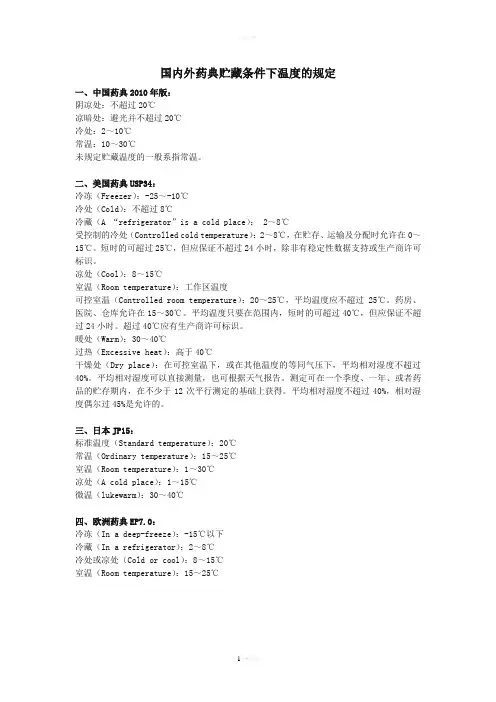
国内外药典贮藏条件下温度的规定一、中国药典2010年版:阴凉处:不超过20℃凉暗处:避光并不超过20℃冷处:2~10℃常温:10~30℃未规定贮藏温度的一般系指常温。
二、美国药典USP34:冷冻(Freezer):-25~-10℃冷处(Cold):不超过8℃冷藏(A “refrigerator”is a cold place): 2~8℃受控制的冷处(Controlled cold temperature):2~8℃,在贮存、运输及分配时允许在0~15℃。
短时的可超过25℃,但应保证不超过24小时,除非有稳定性数据支持或生产商许可标识。
凉处(Cool):8~15℃室温(Room temperature):工作区温度可控室温(Controlled room temperature):20~25℃,平均温度应不超过25℃。
药房、医院、仓库允许在15~30℃。
平均温度只要在范围内,短时的可超过40℃,但应保证不超过24小时。
超过40℃应有生产商许可标识。
暖处(Warm):30~40℃过热(Excessive heat):高于40℃干燥处(Dry place):在可控室温下,或在其他温度的等同气压下,平均相对湿度不超过40%。
平均相对湿度可以直接测量,也可根据天气报告。
测定可在一个季度、一年、或者药品的贮存期内,在不少于12次平行测定的基础上获得。
平均相对湿度不超过40%,相对湿度偶尔过45%是允许的。
三、日本JP15:标准温度(Standard temperature):20℃常温(Ordinary temperature):15~25℃室温(Room temperature):1~30℃凉处(A cold place):1~15℃微温(lukewarm):30~40℃四、欧洲药典EP7.0:冷冻(In a deep-freeze):-15℃以下冷藏(In a refrigerator):2~8℃冷处或凉处(Cold or cool):8~15℃室温(Room temperature):15~25℃欢迎您的下载,资料仅供参考!致力为企业和个人提供合同协议,策划案计划书,学习资料等等打造全网一站式需求。
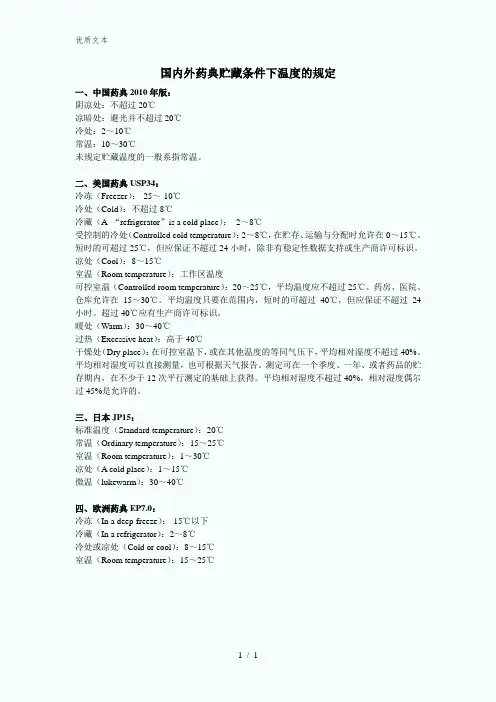
优质文本国内外药典贮藏条件下温度的规定一、中国药典2010年版:阴凉处:不超过20℃凉暗处:避光并不超过20℃冷处:2~10℃常温:10~30℃未规定贮藏温度的一般系指常温。
二、美国药典USP34:冷冻(Freezer):-25~-10℃冷处(Cold):不超过8℃冷藏(A “refrigerator”is a cold place):2~8℃受控制的冷处(Controlled cold temperature):2~8℃,在贮存、运输与分配时允许在0~15℃。
短时的可超过25℃,但应保证不超过24小时,除非有稳定性数据支持或生产商许可标识。
凉处(Cool):8~15℃室温(Room temperature):工作区温度可控室温(Controlled room temperature):20~25℃,平均温度应不超过25℃。
药房、医院、仓库允许在15~30℃。
平均温度只要在范围内,短时的可超过40℃,但应保证不超过24小时。
超过40℃应有生产商许可标识。
暖处(Warm):30~40℃过热(Excessive heat):高于40℃干燥处(Dry place):在可控室温下,或在其他温度的等同气压下,平均相对湿度不超过40%。
平均相对湿度可以直接测量,也可根据天气报告。
测定可在一个季度、一年、或者药品的贮存期内,在不少于12次平行测定的基础上获得。
平均相对湿度不超过40%,相对湿度偶尔过45%是允许的。
三、日本JP15:标准温度(Standard temperature):20℃常温(Ordinary temperature):15~25℃室温(Room temperature):1~30℃凉处(A cold place):1~15℃微温(lukewarm):30~40℃四、欧洲药典EP7.0:冷冻(In a deep-freeze):-15℃以下冷藏(In a refrigerator):2~8℃冷处或凉处(Cold or cool):8~15℃室温(Room temperature):15~25℃1 / 1。

各国药典储存条件汇总药典储存条件的比较2012-11-27美国药典34 欧洲药典7.0 中国药典2010二部冷冻储存-25℃~-10℃深冷低于-15℃冷处不超过8℃冷处2℃~10℃控制的冷处2℃~8℃,允许在0℃~15℃之间冰箱中储存2℃~8℃阴凉储存8℃~15℃阴凉储存8℃~15℃阴凉处不超过20℃凉暗处避光并不超过20℃室温工作区的一般温度控制下的室温储存20℃~25℃,允许在15℃~30℃之间室温储存15℃~25℃常温10℃~30℃温暖30~40℃过热40℃以上干燥储存控制室温下湿度不超过40%见:药品GMP指南《质量控制实验室与物料系统》P387-388药典加速、长期试验条件的比较中国药典二部附录试验名称试验条件备注1 备注2加速试验(一般情况)温度40℃±2℃、相对湿度 75%±5%所用设备应能控制温度±2℃,相对湿度±5%,并能对真实温度和湿度进行检测溶液剂、混悬剂、乳剂、注射液等含有水性介质的制剂可不要求相对湿度加速试验(中间条件)温度30℃±2℃、相对湿度 65%±5%在温度40℃±2℃、相对湿度 75%±5%加速6个月内不符合标准则采用该条件加速试验(温度敏感)温度25℃±2℃、相对湿度60%±10%预计只能在冰箱中保存(4-8℃加速试验30℃±2℃、相对湿度 65%±5%乳剂、混悬剂、软膏剂、乳膏剂、糊剂、凝胶剂、眼膏剂、栓剂、气雾剂、泡腾剂及泡腾颗粒宜直接采用加速试验40℃±2℃、相对湿包装在半透明容器中度 25%±5%药物制剂,例如低密度聚乙烯制备的输液袋、塑料安瓿、眼用制剂容器等长期试验(一般情况)温度在25℃±2℃、相对湿度 60%±10%或温度在30℃±2℃、相对湿度 65%±5%南方、北方气候差异长期试验(温度敏感)6℃±2℃长期试验温度在25℃±2℃、包装在半透明容器中选择由研究者相对湿度 40%±5%或温度在30℃±2℃、相对湿度 35%±5%药物制剂决定药典加速、长期试验条件的比较ICH试验名称试验条件备注1 备注2加速试验(一般情况)温度40℃±2℃、相对湿度 75%±5%加速试验(中间条件)温度30℃±2℃、相对湿度 60%±5%在温度40℃±2℃、相对湿度 75%±5%加速6个月内不符合标准则采用该条件长期试验(一般情况)温度在25℃±2℃、相对湿度 60%±5%美国药典USP35试验名称试验条件备注1 备注2加速试验温度40℃±2℃、相对湿度 75%±5%允许解释数据和信息的短期峰值在储存条件下除了受控室温允许的偏离长期试验温度在25℃±2℃、相对湿度 60%±5%欧洲药品局试验名称试验条件备注1 备注2影响因素试验(原料药)温度:以10℃的增长量(10℃、20℃、……50℃、60℃)高于加速试验相对湿度:≥75%可评估药品在一定PH范围内的溶液或混悬液对水解的敏感性光稳定性研究可作为影响因素试验的必要部分(条件按ICHQ1B)储存条件一般情况长期试验温度在25℃±2℃、相对湿度 60%±5%或温度30℃±2℃、相对湿度 65%±5%选择由研究者决定中间条件温度30℃±2℃、相对湿度 65%±5% 若长期试验条件为温度30℃±2℃、相对湿度 65%±5%,则无中间条件若长期试验条件为温度25℃±2℃、相对湿度 60%±5%,且加速6个月内发生显著变化则应增加中间条件试验以评估显著变化的标准,最初申请应包括12个月的中间条件研究中至少6个月的数据加速试验温度40℃±2℃、相对湿度 75%±5%储存条件在冰箱保存长期试验温度5℃±3℃加速试验温度在25℃±2℃、相对湿度 60%±5%储存条件冷藏长期试验温度-20℃±5℃加速试验在评估温度下进行,5℃±3℃或25℃±2℃储存条件低于-20℃根据个别方案而定制剂储存条件一般情况长期试验温度在25℃±2℃、选择由研究者决定相对湿度 60%±5%或温度30℃±2℃、相对湿度 65%±5%中间条件温度30℃±2℃、相对湿度 65%±5% 若长期试验条件为温度30℃±2℃、相对湿度 65%±5%,则无中间条件若长期试验条件为温度25℃±2℃、相对湿度 60%±5%,且加速6个月内发生显著变化则应增加中间条件试验以评估显著变化的标准,最初申请应包括12个月的中间条件研究中至少6个月的数据加速试验温度40℃±2℃、相对湿度 75%±5%储存条件不透水的容器可在任何可控的或环境湿度条件下进行储存条件半透水的容器选择由研究者决定长期试验温度在25℃±2℃、相对湿度 40%±5%或温度30℃±2℃、相对湿度 35%±5%中间条件温度30℃±2℃、相对湿度 35%±5% 若长期试验条件为温度30℃±2℃、相对湿度 35%±5%,则无中间条件若长期试验条件为温度25℃±2℃、相对湿度 40%±5%,且加速6个月内发生除水分流失外的显著变化则应增加中间条件试验以评估30℃时温度的影响若加速试验中发生的显著变化只是水分流失,则不需要增加中间条件试验,但是应有数据证明在提供的有效期内在温度25℃±2℃、相对湿度40%±5%的条件下不会发生显著的水分流失加速试验温度40℃±2℃、相对湿度不大于25%储存条件冰箱长期试验温度5℃±3℃加速试验温度在25℃±2℃、相对湿度60%±5%储存条件冷藏长期试验-20℃±5℃无加速条件试验但规定在冷藏条件下储存的,应取一批在评估温度(5℃±3℃或25℃±2℃)下进行适当时间的试验,以说明短期内偏离标示储存条件的影响储存条件低于-20℃根据个别方案而定。
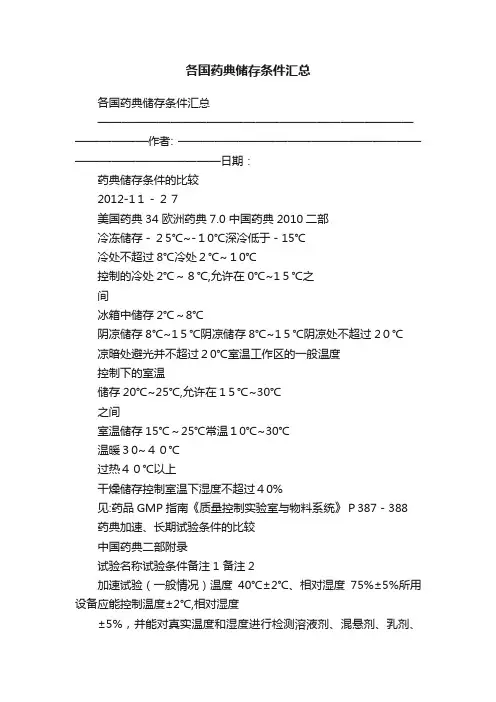
各国药典储存条件汇总各国药典储存条件汇总————————————————————————————————作者: ————————————————————————————————日期:药典储存条件的比较2012-11-27美国药典34 欧洲药典7.0 中国药典2010二部冷冻储存-25℃~-10℃深冷低于-15℃冷处不超过8℃冷处2℃~10℃控制的冷处2℃~8℃,允许在0℃~15℃之间冰箱中储存2℃~8℃阴凉储存8℃~15℃阴凉储存8℃~15℃阴凉处不超过20℃凉暗处避光并不超过20℃室温工作区的一般温度控制下的室温储存20℃~25℃,允许在15℃~30℃之间室温储存15℃~25℃常温10℃~30℃温暖30~40℃过热40℃以上干燥储存控制室温下湿度不超过40%见:药品GMP指南《质量控制实验室与物料系统》P387-388 药典加速、长期试验条件的比较中国药典二部附录试验名称试验条件备注1 备注2加速试验(一般情况)温度40℃±2℃、相对湿度75%±5%所用设备应能控制温度±2℃,相对湿度±5%,并能对真实温度和湿度进行检测溶液剂、混悬剂、乳剂、注射液等含有水性介质的制剂可不要求相对湿度加速试验(中间条件) 温度30℃±2℃、相对湿度65%±5%在温度40℃±2℃、相对湿度75%±5%加速6个月内不符合标准则采用该条件加速试验(温度敏感) 温度25℃±2℃、相对湿度60%±10%预计只能在冰箱中保存(4-8℃加速试验30℃±2℃、相对湿度65%±5%乳剂、混悬剂、软膏剂、乳膏剂、糊剂、凝胶剂、眼膏剂、栓剂、气雾剂、泡腾剂及泡腾颗粒宜直接采用加速试验40℃±2℃、相对湿度25%±5%包装在半透明容器中药物制剂,例如低密度聚乙烯制备的输液袋、塑料安瓿、眼用制剂容器等长期试验(一般情况)温度在25℃±2℃、相对湿度60%±10%或温度在30℃±2℃、相对湿度 65%±5%南方、北方气候差异长期试验(温度敏感)6℃±2℃长期试验温度在25℃±2℃、相对湿度40%±5%或温度在30℃±2℃、相对湿度35%±5%包装在半透明容器中药物制剂选择由研究者决定药典加速、长期试验条件的比较ICH试验名称试验条件备注1 备注2 加速试验(一般情况) 温度40℃±2℃、相对湿度75%±5%加速试验(中间条件) 温度30℃±2℃、相对湿度 60%±5%在温度40℃±2℃、相对湿度75%±5%加速6个月内不符合标准则采用该条件长期试验(一般情况) 温度在25℃±2℃、相对湿度60%±5%美国药典USP35试验名称试验条件备注1备注2 加速试验温度40℃±2℃、相对湿度75%±5%允许解释数据和信息的短期峰值在储存条件下除了受控室温允许的偏离长期试验温度在25℃±2℃、相对湿度60%±5%欧洲药品局试验名称试验条件备注1 备注2 影响因素试验温度:以10℃的增长量(10℃、2可评估药品在一定PH范围内的溶液或(原料药) 0℃、……50℃、60℃)高于加速试验相对湿度:≥75%混悬液对水解的敏感性光稳定性研究可作为影响因素试验的必要部分(条件按ICHQ1B)储存条件一般情况长期试验温度在25℃±2℃、相对湿度60%±5%或温度30℃±2℃、相对湿度 65%±5%选择由研究者决定中间条件温度30℃±2℃、相对湿度65%±5% 若长期试验条件为温度30℃±2℃、相对湿度 65%±5%,则无中间条件若长期试验条件为温度25℃±2℃、相对湿度60%±5%,且加速6个月内发生显著变化则应增加中间条件试验以评估显著变化的标准,最初申请应包括12个月的中间条件研究中至少6个月的数据加速试验温度40℃±2℃、相对湿度75%±5% 储存条件在冰箱保存长期试验温度5℃±3℃加速试验温度在25℃±2℃、相对湿度60%±5%储存条件冷藏长期试验温度-20℃±5℃加速试验在评估温度下进行,5℃±3℃或25℃±2℃储存条件低于-20℃根据个别方案而定制剂储存条件一般情况长期试验温度在25℃±2℃、相对湿度60%±选择由研究者决定5%或温度30℃±2℃、相对湿度65%±5%中间条件温度30℃±2℃、相对湿度65%±5% 若长期试验条件为温度30℃±2℃、相对湿度65%±5%,则无中间条件若长期试验条件为温度25℃±2℃、相对湿度60%±5%,且加速6个月内发生显著变化则应增加中间条件试验以评估显著变化的标准,最初申请应包括12个月的中间条件研究中至少6个月的数据加速试验温度40℃±2℃、相对湿度75%±5%储存条件不透水的容器可在任何可控的或环境湿度条件下进行储存条件半透水的容器长期试验温度在25℃±2℃、相对湿度40%±5%选择由研究者决定或温度30℃±2℃、相对湿度35%±5%中间条件温度30℃±2℃、相对湿度35%±5% 若长期试验条件为温度30℃±2℃、相对湿度 35%±5%,则无中间条件若长期试验条件为温度25℃±2℃、相对湿度40%±5%,且加速6个月内发生除水分流失外的显著变化则应增加中间条件试验以评估30℃时温度的影响若加速试验中发生的显著变化只是水分流失,则不需要增加中间条件试验,但是应有数据证明在提供的有效期内在温度25℃±2℃、相对湿度40%±5%的条件下不会发生显著的水分流失加速试验温度40℃±2℃、相对湿度不大于25%储存条件冰箱长期试验温度5℃±3℃加速试验温度在25℃±2℃、相对湿度60%±5%储存条件冷藏长期试验-20℃±5℃无加速条件试验但规定在冷藏条件下储存的,应取一批在评估温度(5℃±3℃或25℃±2℃)下进行适当时间的试验,以说明短期内偏离标示储存条件的影响储存条件低于-20℃根据个别方案而定。
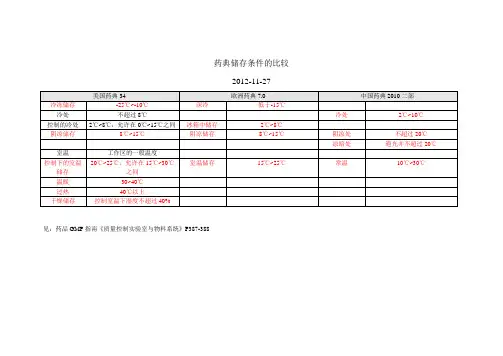
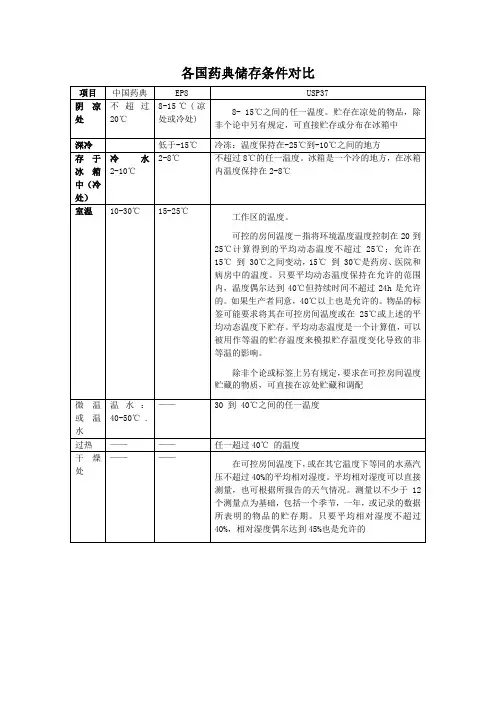
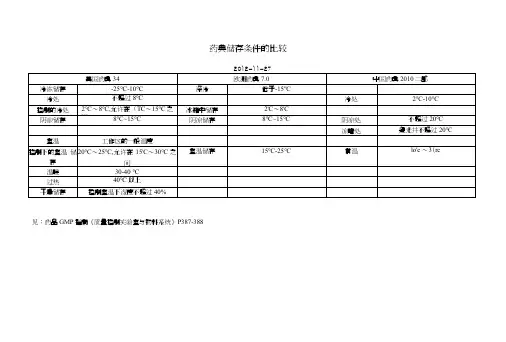
1079 GOOD STORAGE AND DISTRIBUTION PRACTICES FOR DRUG PRODUCTSINTRODUCTIONThis general information chapter describes good storage and distribution practices to ensure that drug products (medicines) reach the end user (practitioners and patient/consumers) with quality intact.In the context of this chapter, the following definitions are used.DefinitionsAdulteration:FDA FDC Act, SEC. 501 (351), A drug or device shall be deemed to be adulterated, if (2)(A) It has been prepared, packed, or held under insanitary conditions it may have been contaminated with filth, or whereby it may have been rendered injurious to health; or (B) the methods used in, or the facilities or controls used for, its manufacture, processing, packing, or holding do not conform to or are not operated or administered in conformity with current good manufacturing practice to assure that such drug meets the requirements of this Act as to safety and has the identify and strength, and meets the quality and purity characteristics, which it purports or is represented to possess.Continuous improvement:Recurring activity to increase the ability to fulfill requirements (see Quality Management Systems—Fundamentals and Vocabulary. ISO Standard 9000:2005).Distribution:Refers to elements such as shipping and transportation activities that are associated with the movement and supply of drug products.Distribution Management System: A program that covers the movement, including storage and transportation, of drug products.Documentation:Recorded information.Drug products:Medicines, including marketed human and veterinary prescription finished dosage medications, in-process/intermediate/bulk materials, drug product samples, clinical trial materials, over-the-counter products (OTC).End user:The patient as well as the healthcare provider administering the drug product to the patient. Environmental Management System: A management system that allows for the identification of quality critical environmental aspects (such as temperature, humidity, and/or other environmental factors) for the drug product and ensures that adequate processes to maintain that environment are in place.Hazardous materials and/or dangerous goods:Any item or chemical which, when being transported or moved, is a risk to public safety or the environment, and is regulated as such under any of the following: Hazardous Materials Regulations (49 CFR 100–180); International Maritime Dangerous Goods Code; Dangerous Goods Regulations of the International Air Transport Association; Technical Instructions of the International Civil Aviation Organization; or the U.S. Air Force Joint Manual, Preparing Hazardous Materials for Military Air Shipments.International Conference on Harmonization (ICH) Guidance for Industry, Q10 Pharmaceutical Quality System; ICH Q9, Quality Risk Management; and, ICH Q1A R2, Stability Testing of New Drug Substances and Products: Internationally harmonized documents intended to assist the pharmaceutical industry.Mean Kinetic Temperature (MKT):The single calculated temperature at which the total amount of degradation over a particular period is equal to the sum of the individual degradations that would occur at various temperatures.Preventive actions:The measures to eliminate the cause of a potential nonconformity or other undesirable potential situation.Quality:The physical, chemical, microbiological, biological, bioavailability, and stability attributes that a drug product should maintain in order to be deemed suitable for therapeutic or diagnostic use. In this chapter, the term is also understood to convey the properties of safety, identity, strength, quality, and purity.Quality Management System (QMS):In the context of this chapter, minimally a set of policies, processes, and procedures that enable the identification, measurement, control, and improvement of the distribution and storage of drug product. It is the management system used to direct and control a company with regard to quality (see ICH Q10 model and Quality System—Fundamentals and Vocabulary, ISO Standard 9000:2005).Risk Management System: A systematic process used to assess, control, communicate, and review risks to the quality of a drug product across the product lifecycle. Integral to an effective pharmaceutical quality system, it is a systematic and proactive approach to identifying, scientifically evaluating, and controlling potential risks to quality as described in ICH Q10. It facilitates continual improvement of process performance and product quality throughout the product lifecycle. ICH Q9 Quality Risk Management provides principles and examples of tools that can be applied to different aspects of pharmaceutical quality.Written Agreement or Contract (commonly referred to as a Quality Agreement, Technical Agreement, ServiceLevel Agreement, or other): A negotiated, documented agreement between the drug product owner and service provider that defines the common understanding about materials or service, quality specifications, responsibilities, guarantees, and communication mechanisms. It can be either legally binding or an information agreement. A Service Level Agreement may also specify the target and minimum level of performance, operation, or other service attributes.Storage Management System: A program that is used to control the storage of drug products.Supply chain:The continuum of entities spanning the storage and distribution lifecycle of a product to the end user.Temperature stabilizer: A material or combination of materials that stores and releases thermal energy used to maintain a specified temperature range within an active or passive packaging container or system (e.g., water-, chemical-, or oil-based phase change material, such as carbon dioxide solid/dry ice and liquid nitrogen). Transport vehicles:Vehicles used in the supply chain including semitrailer trucks, vans, trains, airplanes, sea vessels, and mail delivery vehicles. Other vehicles, when used to transport drug products are included here, such as emergency medical service vehicles and industry representatives’ automobiles.SCOPEGood storage and distribution practices apply to all organizations and individuals involved in any aspect of the storage and distribution of all drug products, including but not limited to the following:Manufacturers of drug products for human and veterinary use where manufacturing may involve operations at the application holder’s facilities (i.e., facilities that belong to the holder of an approved New DrugApplication or Abbreviated New Drug Application) or at those of a contractor for the applicant holderPackaging operations by the manufacturer or a designated contractor for the applicant holderRepackaging operations in which the drug product may be owned by an organization other than theprimary manufacturerLaboratory operations at the manufacturer’s or at the contractor’s sitePhysician and veterinary officesPharmacies including but not limited to retail, compounding, specialty, mail order, hospital, and nursing home pharmaciesImporters and exporters of RecordWholesale distributors; distribution companies involved in automobile, rail, sea, and air servicesThird-party logistics providers, freight forwarders, and consolidatorsHealth care professional dispensing or administering the drug product to the end userMail distributors including the U.S. Postal Service (USPS) and other shipping services includingexpedited shipping servicesThe information is intended to apply to all drug products regardless of environmental storage or distribution requirements.It is recognized that conceivably there are special cases and many alternative means of fulfilling the intent of this chapter and that these means should be scientifically justified. Although this chapter is not intended to address the storage and distribution of active pharmaceutical ingredients (APIs), excipients, radioactive products, reagents, solvents, medical devices, medical gases, or clinical trial materials for which storage requirements may not yet be defined (e.g., Phase I clinical trial drug products), the general principles outlined here may be useful if applied selectively or comprehensively.This general information chapter does not supersede or supplant any applicable national, federal, and/or statestorage and distribution requirements, or USP monographs. General Chapter 659 Packaging and Storage Requirements contains definitions for storage conditions. This chapter is not intended to cover counterfeiting, falsified medicines, drug pedigrees, or other supply chain security, including chain of custody issues.BACKGROUND INFORMATIONStorage and distribution processes may involve a complex movement of product around the world, differences in documentation and handling requirements, and communication among various entities in the supply chain. The translation of best practices into good storage and distribution meets these challenges and sets forth a state of control.The good storage and distribution practices described in this chapter should facilitate the movement of drug products throughout a supply chain that is controlled, measured, and analyzed for continuous improvements and should maintain the integrity of the drug product in its packaging during storage and distribution.RESPONSIBILITIESThe holder of the drug product application, the drug product manufacturer (in the case of many OTCs, where there is no application) and the repackager bear primary responsibility and accountability including but not limited to the following:The decision for regulatory submissions, where applicable, relative to the contents of this chapter for the storage and distribution of drug products. If breaches occur in any of the QMS systems and cannot bejustified or documented with scientific evidence, the appropriate entity should consider action with theproduct to ensure the public safety.Determining proper storage and handling practicesCommunicating storage and distribution practices through the supply chainDrug product stability profiles or the associated stability information from the holder, inclusive ofdistribution conditions and excursions that may be allowable should they occur. These stability profilesinclude the approved storage conditions for the shelf life of the drug product and, where appropriate,supporting data for the distribution conditions, if these differ from the storage conditions.Appropriate firms, such as an applicant holder, are to convey relevant environmental requirements (e.g., when appropriate, product-specific lifecycle stability data), when needed to support deviations ortemperature excursions. If stability data cannot be reviewed or is not shared, an assessment may beneeded to consider regulatory review or other appropriate actions (e.g., destruction of product oradditional stability testing).Recalling the drug product if it is found to be adulterated in any part of the supply chainHowever, all organizations along the supply chain bear responsibility for ensuring that they handle drug products within adequate storage and distribution parameters that will not affect the drug product identity, strength, quality, purity, or safety.Each holder of drug product is responsible and accountable for the receipt from an entity and transfer out of the drug product to the next entity.LABELING CONSIDERATIONS FOR DRUG PRODUCTSThe environmental requirements for drug product storage conditions should be indicated on the drug product primary container–closure system. If space on the immediate container is too small (e.g., an ampule) or is impractical for the container–closure system (e.g., blister package), this information can be placed on the most immediate container of appropriate size (e.g., carton). Environmental storage conditions and/or environmental warning statements should be evident, securely fixed, and indelible on the outermost container (generally the shipping container).Products classified as hazardous materials and/or dangerous goods by the U.S. Department of Transportation or other relevant authorities or bodies should be labeled, stored, and handled in accordance with applicable federal/state/local regulations. Drug products classified as controlled substances by the U.S. Drug Enforcement Administration or by individual state requirements should be labeled and handled in accordance with applicable regulations.Good practices and controls for labeling should provide the receiver with instructions for the correct handling of the drug product upon receipt. When a drug product’s storage conditions are not readily available, use the storage conditions described in USP’s General Notices and Requirements or the applicable USP monograph; or, contact the drug manufacturer for further information.Product labels with expanded information beyond the single long-term storage temperature ensure ease of transport and use for shippers, distributors, healthcare professionals, and patients. Product labels should clearly define the storage temperature range, and broader distribution or in-use temperature ranges where allowable. Products labeled “Keep in a cold place” or “Do not freeze” are subject to interpretation and are discouraged if used without accompanying temperature ranges. USP storage definitions and temperature ranges are defined in General Notices and Requirements.During international transport, the proper language(s) should be used to ensure that handlers understand the requirements set forth on drug product labeling. The use of symbols that are recognized by international organizations is advisable.Drug products can be transported at temperatures outside of their labeled storage temperatures if stability data and relevant scientific justification demonstrate that product quality is maintained. The length of the stability studies and the storage conditions for a drug product should be sufficient to cover the shipment, distribution, and subsequent use of the drug product. The data gathered from ICH, Q1A R2, accelerated testing or from testing at an ICH intermediate condition may be used to evaluate the effect of short-term excursions outside of the label storage conditions that might occur during storage and/or distribution.QUALITY MANAGEMENT SYSTEMGood storage and distribution practices require that entities involved in the storage and/or distribution of drug products maintain a Quality Management System (QMS) that is based on standard quality concepts, includes good manufacturing practice (GMP) in compliance with the appropriate regulatory agency(s), and is complementary to the ICH quality guidances, including ICH Q10 Pharmaceutical Quality System and ICH Q9 Quality Risk Management. In the context of this chapter, the QMS includes the following management system programs: (1) Storage Management System, (2) Distribution Management System, (3) Environmental Management System, and (4) Risk Management System.The storage and distribution QMS should, at minimum, cover the following elements: corrective and preventive actions (CAPA), change management, deviation/investigation management, and the management review process.Written agreements (e.g., Quality Agreement, Technical Agreement, Service Level Agreements) should be in place between applicable organizations involved in the drug product supply chain. This means that the originating manufacturer may not be required to hold a Written Agreement with all parties in the supply chain. The use of written agreements ensures clarity and transparency, and delineates the responsibilities of each organization in the supply chain.Good Documentation PracticesGood documentation practices should be practiced in the QMS. This documentation includes standard operating procedures and corporate policies and standards, as well as protocols and other written documents that delineate the elements of the QMS. The QMS programs should describe events and actions that must be documented as well as the proper verbiage to be used, the copies required, and any other items that will ensure adequate processing of the drug product and prevent delays. The documentation process should use a standard such as a quality manual or other practice and, should include routine assessment for review and update as needed.Written procedures should ensure that drug products are held in accordance with their labeling instructions and associated regulatory requirements. Procedures should provide the written steps needed to complete a process and ensure consistency and standard outcomes. The following elements should be included: (1) how and when a product should be moved from one transport container/vehicle into another, (2) how products are handled when equipment malfunctions or when there are delays in distribution due to Customs hold, and (3) how to communicate with the necessary parties.The QMS should require monitoring of processes to demonstrate that a state of control is being maintained, where the set of controls consistently provides assurance of continued process performance and product quality (ICH Q10).If deviations occur, a nonconformance should be documented, and investigation should be performed and documented as appropriate. The investigative process should determine the root cause(s) of the deviation. For example, the following should be determined: whether the drug product experienced stress, damage, delays, or environmental lapses, or whether there were errors in documentation. The associated supply quality management staff should have final responsibility for approving or rejecting the investigation. The investigation process should be linked to the risk management program to ensure that proper mitigation occurs and preventive measures are put in place.For example, a written investigation should be performed if the receiving and/or transferring processes result in a drug product being subjected to unacceptable temperature conditions or contamination (e.g., pests, microorganisms, or moisture). Any breach of standard operating procedures should be documented with a risk justification as needed. This information should be forwarded to the appropriate organization responsible for the drug product. The drug product should be quarantined, and final disposition should be based on good science with appropriate evidence to justify the decision(s).Manufacturers should develop written procedures for recording the security process that confirms container–closure integrity for drug products that require special handling, such as security seals for controlled substances. Returned and salvaged goods records should address how the drug product is assessed through a written procedure. In addition, training on such procedures should be part of the QMS.Records should be retained for purchases and sales of drug products and should show the date of purchase or supply; the name of the drug product and the amount; the name and address of the supplier or consignee; and the associated lot numbers. These records should allow for the traceability of a drug product in the supply chain. All records and documents should be maintained in accordance with a traceable records-retention program and should be made available upon request to regulatory agencies. These documents should be approved, signed, and dated by the department responsible for the QMS.Storage Management Systemstorage locations and processesIt is important that each entity define their appropriate storage locations to ensure that adequate controls are in place. These locations include buildings and facilities for drug product storage (e.g., warehouse, storage or hold area, the original manufacturer’s warehouses, contractor warehouses, wholesale distribution warehouses, mail order or retail pharmacy storage area, hospital or nursing home pharmacy storage areas; and border Customs storage areas).In these locations, two basic processes can occur. First, receiving for storage is the act of bringing a drug product into a facility, while transferring refers to the moving of a drug product internally within a facility or into or out of a vehicle. Second, storing and holding refers to the act of maintaining temporary possession of a drug product in the supply chain process, during which no movement of the product will occur.storage in buildings and facilitiesDrug product storage areas are required to maintain the product temperature between the limits as defined on the product label. Buildings and facilities used for the warehousing, storage, and/or holding of drug products should be of adequate size for their intended use. These facilities should be adequate to prevent overcrowding. The building and facility should be designed to control environmental conditions where necessary and should be made of readily or easily cleanable materials. Sanitation and pest control procedures should be written, indicating frequency of cleaning and the materials and methods used. The pest-control program should ensure the prevention of contamination as well as the safe use of pesticides. Records of all cleaning and pest-control activities should be maintained.Storage should be orderly and should provide for the segregation of approved, quarantined, rejected, returned, or recalled drug product. If computerized systems are used for the control of storage conditions, the software should be appropriately qualified for its intended purposes. Facilities should have controls that mitigate risks such as fire, water, or explosion. Certain drug products may cause these risks and should be stored accordingly. Storage areas, when not computerized, should be appropriately visually labeled.Storage facilities themselves, unless thermostatically controlled, cannot be validated; however, they can be qualified via a mapping process. The generator back-up power supply should be qualified.receiving and transferring drug productsStorage of a drug product includes not only the period during which the drug product is held in the manufacturer’s storage areas but also time spent at the receiving bay area. When drug products arrive at warehouse loading docks and other arrival areas, they should be transferred as quickly as possible to a designated storage or within a time period that is consistent with the risk and exposure of the product in the receiving area to a designated storage environment to ensure minimal time outside specified storage conditions as described in a written procedure.Relative to the incoming receipt of drug product, it is recognized that the process of product reaction to ambient conditions begins immediately and may occur quickly (e.g., reach temperature equilibrium within minutes to a few hours depending on details such as the product mass, volume, and packaging density taking into account secondary and tertiary packaging)1. Time spent in a transport vehicle is considered to be part of the distribution process and is not a storage location.Receiving docks should protect drug product deliveries from inclement weather during unloading. Any storage area, including loading and unloading docks for receipt and distribution of drug products, should be clean, cleanable, and free from pests. The incoming receiving area should limit access to authorized persons. Where appropriate, the delivery vehicle/container should be examined before unloading to ensure that adequate protection from contamination was maintained during transit. Deliveries should be examined at receipt in order to check that containers are not damaged and that the consignment corresponds to the order. The results of this examination should be documented.Areas should be designated to provide an adequate space in which containers of drug products can be cleaned and opened for sampling. If sampling is performed in the receiving area, it should be done in a manner that prevents contamination and cross-contamination and ensures that environmental requirements for the drug product are not breached.Adequate precautions should be taken to prevent theft and diversion of drug products. Drug products that have been identified as counterfeit should be quarantined to prevent further distribution. The appropriate regulatory agencies should be contacted according to established procedures.Appropriate delivery records (e.g., as applicable, transport vehicle movement papers, receiving/delivery records, data logging records, temperature recorders and similar devices, bill of lading, house air waybill, master air waybill, etc.) should be reviewed by each receiving entity in the supply chain to determine if the product has been subjected to any transportation delays or other events that could have exposed the product to undesirable conditions. Each entity should ensure that their respective Service Level Agreement documents and supporting documents such as SOPs cover delivery and receiving responsibilities of the transactional parties.Smoking, eating, and drinking should not be permitted in any storage/hold areas.refrigerators and freezersRefrigerators and freezers used to store drug products are required to maintain the product temperature between the limits as defined on the product label. Typically, a refrigeration unit specification would be set to 5 with an allowable range of ±3 to store products labeled 2–8. Freezer temperatures may vary and typically range from25 to 10. Some frozen drug products, however, require lower temperatures, e.g., dry ice or liquid nitrogen temperatures.Regular operating procedures and maintenance protocols should be in place along with written contractual agreements for all maintenance and evaluation procedures including the following:1. Items should be stored in the units in a manner that allows adequate air flow to maintain the specifiedconditions.2. Units should be positioned in the facility so that they are not subjected to environmental extremes thatcould affect their performance. If this cannot be prevented, the mapping protocol should include aprovision for testing during the anticipated environmental extremes.3. Large commercial units such as walk-in cold rooms are qualified via a temperature mapping study orother type of qualification process to determine the unit’s suitability for storing drug products. A suitable number of temperature-recording devices should be utilized to record temperatures and to providetemperature area maps. Thereafter, the units should be monitored as determined by the results of themapping study. Refer to the Temperature Monitoring section under Environmental Management System.4. Units should utilize recording systems to log and track temperatures. Alarm systems should be anintegral part of the monitoring system for both refrigerators and freezers. While automated systemsmonitor units continuously, manual checks should be performed as appropriate to the validation program.When automated systems are not available, manual systems may be used.Distribution Management SystemDistribution of drug products occurs within a facility or location such as a manufacturer, wholesaler, pharmacy dispensing area, retail site, clinic/hospital/nursing home pharmacy, and the physician’s practice. Distribution of drug products occurs as point-to-point movement within the supply chain between distribution facilities via semitrailer trucks, vans, emergency medical service vehicles, industry representatives’ automobiles, trains, aircraft, sea vessels, and mail delivery vehicles.Communication within the supply chain should be coordinated to determine proper timing for drug products to be transported and received, taking into account holiday schedules, weekends, or other forms of interruption. When international distribution is required, alerts should be made in advance and proper language should be used to ensure understanding of the requirements set forth on drug product labeling.packaging for the distribution and transportation processesPharmaceutical manufacturers should consider primary, secondary, and tertiary packaging that best protects the drug product during storage and distribution. Package performance testing should be documented as part of a manufacturer’s QMS. Several standard test procedures are available for evaluating package performance for factors such as shock, vibration, pressure, compression, and other transit events. Organizations with standard test methods include the following: the American Society for Testing and Materials (ASTM) Standard Practice for Performance Testing of Shipping Containers and Systems, and the International Safe Transit Association (ISTA) specifications for various types of transit modes such as less-than-truckload, small package, rail car, and air freight.It is important to be aware that removal or modification of the original packaging may subject the product to unacceptable conditions.The packaging (tertiary or thereafter) for the distribution of the drug product should be selected and tested to ensure that product quality is maintained and to protect the contents from the rigors of distribution including environmental or physical damage.All drug products have storage requirements that may contain specific controls. The container used for transporting the drug product should be qualified on the basis of the labeled conditions of the product as well as anticipated environmental conditions. Consideration should be made for seasonal temperature differences, transportation between hemispheres, and the routes and modes of transport.The type, size, location, and amount of the temperature stabilizers required to protect the product should be based on documented studies of specific distribution environments including domestic and international lanes, mode(s) of transport, duration, temperature, and other potential environmental exposures or sensitivities that may impact product quality. Transportation container materials such as warm/cold packs and materials used to control temperature conditions should be properly conditioned before use. Barrier protection may be important in helping to determine the position of materials such as gel packs in order to avoid direct contact with the drug。
美国药典中的药品存储条件-Temperature and storage definitions在日常工作中,经常有很多同学被药品存储条件的字面意思搞迷糊掉。
比如cold是多冷?controlled是控到多少?room temperature是多少度?诸如此类,其是困扰。
其实这些条件均来自美国药典USP,请见下面有关定义和中文解释。
1 .freezer:一个温度控制在・25到-10°C的地方。
2.Referigerator:—个温度控制在2-8°C的地方3.cold:任何温度不超过8°C的地方4.cool:任何温度在8到15°C的地方5.room temperature:温度普遍和工作环境相当,也叫环境温度(Ambient temperature)6.contolled room temperature:温度维持在20到25°C之间。
但这条美国药典有进一步的解释,Mean kinetic temperature not exceed25°.Excurions between 15 and 30° that are experienced in pharmacies, hospitals, and warehouses, and during shipping areallowed.Provided the mean kinetic temperature does not exceed 25°,transient spikes up to 40° are permitted as long as they do not exceed 24h. Spike above 40° may be permitted only if the manufactures so instructs.就是说,对于控制的室温这个存储条件来讲,如果大部分时间没有超25°,短时间在15到30°,经验上是没有问题的。
国内外药典贮藏条件下温度的规定一、中国药典2010年版:阴凉处:不超过20℃凉暗处:避光并不超过20℃冷处:2~10℃常温:10~30℃未规定贮藏温度的一般系指常温。
二、美国药典USP34:冷冻(Freezer):-25~-10℃冷处(Cold):不超过8℃冷藏(A “refrigerator”is a cold place):2~8℃受控制的冷处(Controlled cold temperature):2~8℃,在贮存、运输及分配时允许在0~15℃。
短时的可超过25℃,但应保证不超过24小时,除非有稳定性数据支持或生产商许可标识。
凉处(Cool):8~15℃室温(Room temperature):工作区温度可控室温(Controlled room temperature):20~25℃,平均温度应不超过25℃。
药房、医院、仓库允许在15~30℃。
平均温度只要在范围内,短时的可超过40℃,但应保证不超过24小时。
超过40℃应有生产商许可标识。
暖处(Warm):30~40℃过热(Excessive heat):高于40℃干燥处(Dry place):在可控室温下,或在其他温度的等同气压下,平均相对湿度不超过40%。
平均相对湿度可以直接测量,也可根据天气报告。
测定可在一个季度、一年、或者药品的贮存期内,在不少于12次平行测定的基础上获得。
平均相对湿度不超过40%,相对湿度偶尔过45%是允许的。
三、日本JP15:标准温度(Standard temperature):20℃常温(Ordinary temperature):15~25℃室温(Room temperature):1~30℃凉处(A cold place):1~15℃微温(lukewarm):30~40℃四、欧洲药典EP7.0:冷冻(In a deep-freeze):-15℃以下冷藏(In a refrigerator):2~8℃冷处或凉处(Cold or cool):8~15℃室温(Room temperature):15~25℃。
美国药典标准美国药典(United States Pharmacopeia, USP)是美国药典委员会(United States Pharmacopeial Convention, USP)制定的一套药品标准,旨在保障药品的质量、安全和有效性。
美国药典标准的制定经过严格的科学研究和专家评审,是世界范围内公认的权威药品标准之一。
本文将对美国药典标准进行介绍,以便更好地了解其在药品生产和使用中的重要作用。
首先,美国药典标准的内容涵盖了药品的各个方面,包括药品的成分、制剂、质量控制、储存和使用等。
其中,药品的成分是指药品中所含有的活性成分和辅料成分,美国药典对药品成分的纯度、含量、稳定性等方面都有详细的规定。
制剂则是指药品的剂型、规格、生产工艺等方面的要求,美国药典对药品的制剂要求严格,以确保药品的质量和稳定性。
此外,美国药典还对药品的质量控制、储存和使用等方面进行了规定,以保证药品在整个生产和使用过程中的质量和安全性。
其次,美国药典标准的制定是经过严格的科学研究和专家评审的。
美国药典委员会由来自医学、药学、化学、生物学等多个领域的专家组成,他们经过长期的研究和实践,制定了一系列科学合理的药品标准。
这些标准不仅考虑了药品的疗效和安全性,还充分考虑了药品的生产工艺、质量控制和使用方便性等因素,以确保药品在生产和使用中的全面质量。
此外,美国药典标准的制定是为了保障药品的质量、安全和有效性。
药品是人们维护健康的重要手段,而药品的质量和安全性直接关系到人们的生命健康。
因此,美国药典标准的制定是为了保证药品的质量和安全性,以及药品的有效性。
只有符合美国药典标准的药品,才能获得生产许可和上市许可,从而保障人们在使用药品时的安全和有效性。
总之,美国药典标准是保障药品质量、安全和有效性的重要手段。
其严格的制定程序和科学合理的内容,确保了药品在生产和使用中的全面质量。
因此,我们在选择和使用药品时,应当选择符合美国药典标准的药品,以保障自己的健康和安全。
国内外药典贮藏条件下温度的规定一、中国药典2010年版:阴凉处:不超过20℃凉暗处:避光并不超过20℃冷处:2~10℃常温:10~30℃未规定贮藏温度的一般系指常温。
二、美国药典USP34:冷冻(Freezer):-25~-10℃冷处(Cold):不超过8℃冷藏(A “refrigerator”is a cold place): 2~8℃受控制的冷处(Controlled cold temperature):2~8℃,在贮存、运输及分配时允许在0~15℃。
短时的可超过25℃,但应保证不超过24小时,除非有稳定性数据支持或生产商许可标识。
凉处(Cool):8~15℃室温(Room temperature):工作区温度可控室温(Controlled room temperature):20~25℃,平均温度应不超过25℃。
药房、医院、仓库允许在15~30℃。
平均温度只要在范围内,短时的可超过40℃,但应保证不超过24小时。
超过40℃应有生产商许可标识。
暖处(Warm):30~40℃过热(Excessive heat):高于40℃干燥处(Dry place):在可控室温下,或在其他温度的等同气压下,平均相对湿度不超过40%。
平均相对湿度可以直接测量,也可根据天气报告。
测定可在一个季度、一年、或者药品的贮存期内,在不少于12次平行测定的基础上获得。
平均相对湿度不超过40%,相对湿度偶尔过45%是允许的。
三、日本JP15:标准温度(Standard temperature):20℃常温(Ordinary temperature):15~25℃室温(Room temperature):1~30℃凉处(A cold place):1~15℃微温(lukewarm):30~40℃四、欧洲药典EP7.0:冷冻(In a deep-freeze):-15℃以下冷藏(In a refrigerator):2~8℃冷处或凉处(Cold or cool):8~15℃室温(Room temperature):15~25℃欢迎您的下载,资料仅供参考!致力为企业和个人提供合同协议,策划案计划书,学习资料等等打造全网一站式需求。
美国药典中的药品存储条件-Temperature and storage definitions
在日常工作中,经常有很多同学被药品存储条件的字面意思搞迷糊掉。
比如cold是多冷?controlled 是控到多少?room temperature是多少度?诸如此类,甚是困扰。
其实这些条件均来自美国药典USP,请见下面有关定义和中文解释。
1.freezer:一个温度控制在-25到-10℃的地方。
2.Referigerator:一个温度控制在2-8℃的地方
3.cold:任何温度不超过8℃的地方
4.cool: 任何温度在8到15℃的地方
5.room temperature:温度普遍和工作环境相当,也叫环境温度(Ambient temperature)
6. contolled room temperature: 温度维持在20到25℃之间。
但这条美国药典有进一步的解释,Mean kinetic temperature not exceed 25°.Excurions between 15 and 30° that are experienced in pharmacies, hospitals, and warehouses, and during shipping are allowed.Provided the mean kinetic temperature does not exceed 25°,transient spikes up to 40° are permitted as long as they do not exceed 24h. Spike above 40° may be permitted only if the manufactures so
instructs. 就是说,对于控制的室温这个存储条件来讲,如果大部分时间没有超25°,短时间在15到30°,经验上是没有问题的。
并且如果平均温度没有超过25°,24小时内最高高温没有超过40°的话也是可以接受的,如果超过40°,就不行了,除非药品生产者有专门的评估和说明。
7.Warm: 温度在30到40°的地方
8. Excessive heat:任何超过40°的地方
9.Dry place: 一个地方,在20℃时的平均相对湿度没有超过40% 或者等于在其他温度下的蒸气压(water vapor pressure).
10.Protect from freezing: 就是别把药品包装冻坏了温度。
主要有一些容器在低温下可能会破坏。
具体温度得看容器和物料的低温膨胀性。
物料容器上必须贴上明显的标识。
11.Protect from light: 存储物料怕光。
如果有这样的要求,物料容器上必须贴上明显的怕光之类的描述
经过老枪这样一描述,应该不会再迷惑了吧。
以上参考USP40-NF35。